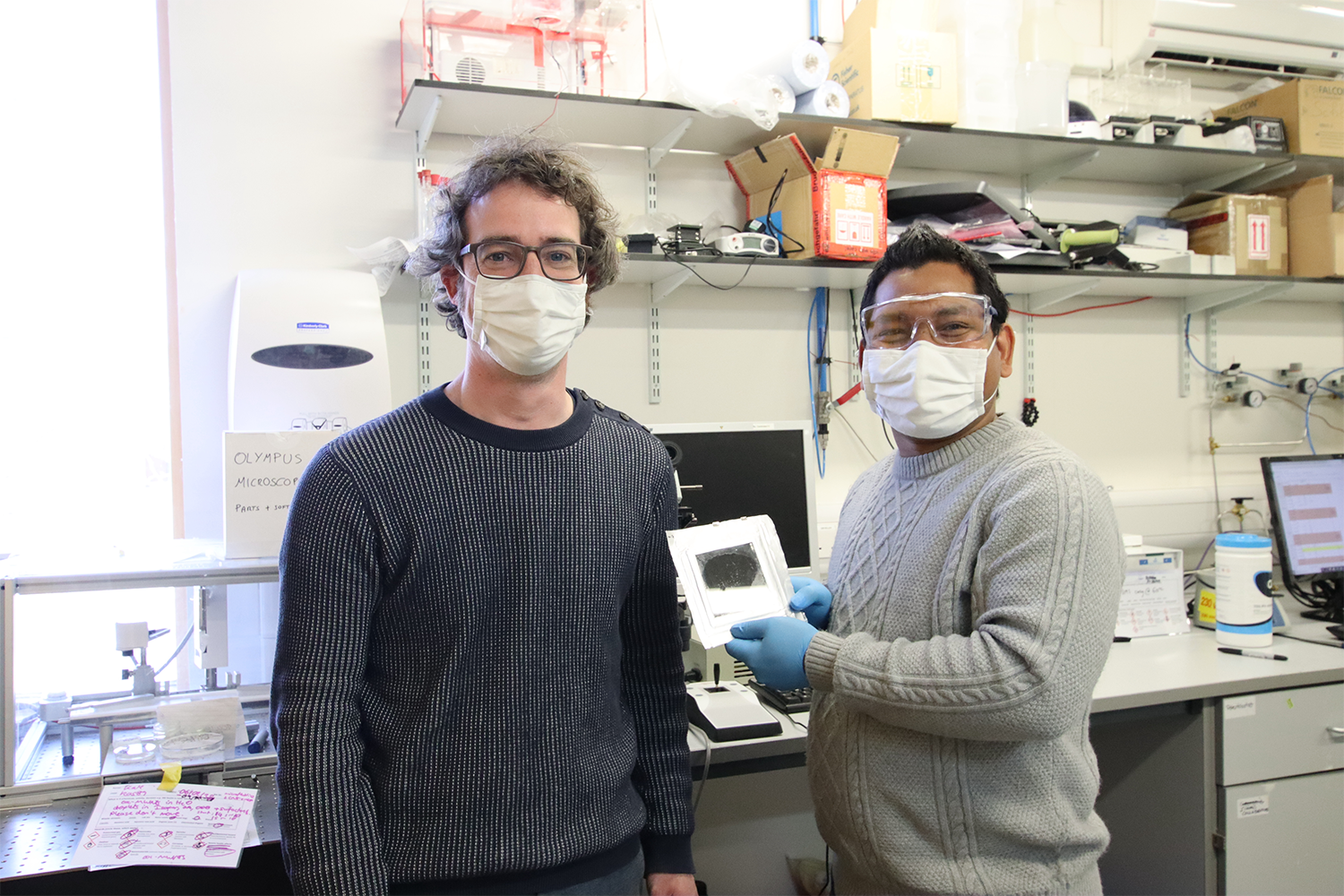
Professor Michael De Volder tells us how a Friday afternoon experiment led to research on a new low-cost battery design that can be charged directly by light without a separate solar cell or power converter.
One area we have made clear progress in is improving the stability of the batteries as they are charged and discharged, bringing it closer to what you would expect from a commercially available battery.
Professor Michael De Volder
Interview by Jason Naselli.
How does what you’re working on differ from conventional batteries?
For most of us, recharging a battery is easy. When a battery is flat, you plug it into a charger and after an hour or so you are good to go. But in a remote area, without access to mains electricity, this becomes much more complicated.
You can of course use solar power to charge batteries in off-grid locations, but this always requires a separate solar cell and a power converter, in addition to the battery, which makes solar charging systems more expensive and less robust.
What we have developed is a way to charge the battery directly from sunlight — no separate solar cell, no power converter. So we’ve reduced those three components to just one, a battery that can be exposed directly to light and recharges all by itself, without any external intervention. It’s quite neat.
We’re also using zinc-ion batteries, which are fairly cheap, so we believe that it will be possible to have the light-charging capability for the cost of a normal battery.

Professor Michael De Volder and Dr Buddha Deka Boruah with the photo battery prototype. Image: Institute for Manufacturing (IfM).
You’ve said that this is a proof-of-concept and that further testing is needed. But what are some of the applications that you envision?
Exactly, this is a proof of concept, and it is technology still in its very early days. One problem we still have to solve is increasing our efficiency in converting energy from sunlight to energy stored in the battery. Conventional solar cells have an energy conversion efficiency of 10–20 per cent, whereas the efficiency of our battery is still below one per cent. So we think this technology mostly has applications in situations where the energy conversion efficiency isn’t the most important criteria, as compared to the price or volume.
If we think of technologies such as the Internet of Things, or sensors that are used in smart cities which are distributed over large areas and not connected to mains power supplies, those are sometimes exposed to the sun for many hours a day but consume very small amounts of energy. Therefore, you don’t need a very high energy conversion system, but having a compact energy solution is important.
Also, for parts of the world where people are trying to fight energy poverty, having a system that is able to harvest sunlight and store its energy cost-effectively would be extremely useful. Where cost and safety might be more important considerations than energy conversion efficiency, this technology is quite promising.
Given the possibilities here, the obvious question is: why hasn’t this been tried before? Where did the idea come from?
As is often the case, it was a bit of serendipity. One of my post-doctoral researchers, Shahab Ahmad, who’s now a professor at IIT Jodhpur, was developing perovskite-based batteries, focusing on the possibilities for energy storage. But we became disappointed by the lifetime of the batteries, as I mentioned.
So, in a Friday afternoon experiment, we exposed these batteries to light, because we knew that perovskites are very good at light harvesting. And we saw strange things when we exposed the battery to light! We saw that the voltage output of the battery was going up — it was charging. And then we started investigating this in more detail.
What we found was that other researchers in the 1980s had looked at this idea, but for various reasons it was abandoned. Efficiency could be one of them, the low lifetime of the batteries could be one of them. But with the current, more orchestrated efforts of developing lithium-ion batteries for the electrification of our society, there is more understanding of how the batteries work and it’s the right time to pick that research back up and see where it can lead.
You’re still working on conversion efficiency, but have you made progress in other areas?
Absolutely. One area we have made clear progress in is improving the stability of the batteries as they are charged and discharged, bringing it closer to what you would expect from a commercially available battery.
We’ve now published a couple of papers on this topic. Back when we first reported on it, we were using a class of materials for the batteries called perovskites, which are used in photovoltaics quite often because they can achieve high efficiencies in energy conversions. But when we made those batteries, after about 5 to 10 charge-discharge cycles, the battery would be dead. That’s obviously not great and we are trying to improve their stability.
At the same time, we are investigating various metal oxide materials rather than perovskites, and with those we can hit hundreds of charge-discharge cycles.
We also haven’t done any field trials, deploying the batteries in real situations or exposing them to the sun and hot environments. We’ve only done lab-based tests with solar simulators, which is never quite the same as the real world. So that’s a work in progress.
It sounds very exciting. What is the next step?
Well, in addition to increasing the number of charge-recharge cycles and the charging efficiency, we also want to improve the output voltages. The initial batteries we produced were limited to one volt, so we are working quite hard on how to get that up, closer to 3 volts of output, which will make them much more viable.
We also need to look at it from different perspectives. To date, the development of our materials has mainly come from the battery angle. In our group, we mainly work on batteries and not so much on photovoltaics. And the design of our devices so far is built very much on our understanding of batteries and very little on the process of converting light into energy. I think there is a lot of improvement possible simply in adopting design principles from photovoltaics — these have not been fully explored in our devices, so that’s where we think we can increase the efficiency the most. There are still a lot of ways we can make this even better.
Dr Buddha Deka Boruah, Angus Mathieson, Lifu Tan and Dr Shahab Ahmad contributed to this work.
This article originally appeared on the IfM Medium blog.

